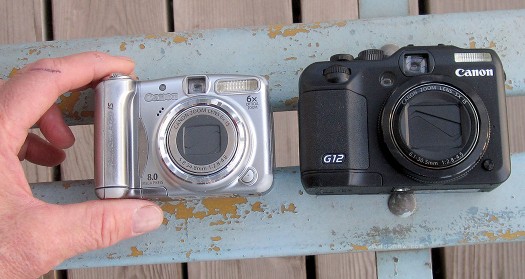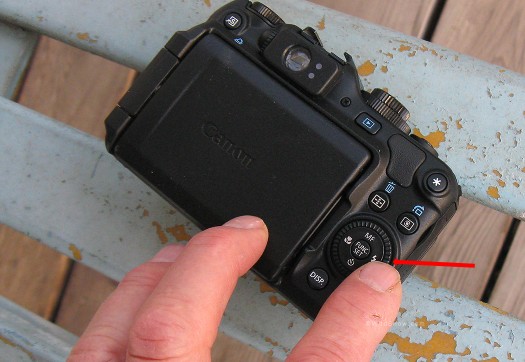My cheapo but amazing Canon A720 was called by the big photoshopper in the sky. Upgrade ensued with the inevitability of replacing carburation with fuel injection. Now I’m the proud owner of a Canon G12 that’s clunky compared to Canon A-series cams, but has better glass and a better sensor.

Out with the old, in with the new. A720 to left has more zoom at 6X instead of 5X, but nearly everything else is inferior to G12 in one way or another. The size and weight are a joy, however.
Can I make better photos with the G12 talisman hanging from my nicely corn snow tanned neck? Probably, albeit with frustrating limitations due to the ergonomics and really rather simplistic software of the G12.
Simplistic? More than five years ago, Canon approached the pinnacle of point&shoot digicam software in cameras such as their A620. Subsequent cameras have similar feature sets that are intentionally crippled in one way or another so as not to cut sales of higher priced units.
What’s funny about the feature sets, and sad, is that with the now pleistocene A620 you could do nearly anything the current G12 does, though the sensor and dynamic range of the 620 were about as far from that of the 12 as a cave man’s fire is from a nuclear reactor. Thus, “crippled” might be too strong a word, but options in the G12 software are amazingly few for a pretty much pro-level cam. To be fair, perhaps this lack of software features is due to a simplification effort on Canon’s part. In that sense, good, it is indeed easy to learn this rig. Spend a few evenings going though the settings instead of watching Youtube re-runs, and you’ll know just about everything.
Ok, despite all that I like the G12. Mainly because of the following:
1. The flip out LCD is a joy for getting away from the usual camera positions. It was also a joy with the A620, but that’s history.
2.Burst mode is fast enough to shoot skiing with good chance for success. I have never found a usable P&S that shot burst mode worth beans.
3. The G12 color management and dynamic range make shooting snowscapes much easier (and images can be captured in RAW for control that will keep you up all night tweaking the colors of pine needles and your girlfriend’s irises). Overall image quality is, simply, better.
I’m still an advocate of using consumer point&shoot cameras wherever possible in backcountry setting due to their “throw away” nature and small size (Canon A720 still our highest recommend, due to optical viewfinder.
But for someone who’s essentially a professional photographer (me), something with higher quality results is probably smart. For example, even my best composed and Photoshopped shot from my P&S rigs in some cases simply isn’t up to the standard of what a magazine would buy for a fullpage spread. More, due to grain and lack of tonal separations my P&S shots are much less croppable than those of this higher quality unit. Most importantly, why not up the quality of the shots I publish nearly every day on the web?
4. Quality glass makes my shots better with no more effort on my part than with my cheaper rigs.
5. Two custom settings modes (C1, C2) store most of a camera settings, which perfect if you do one type of photography quite a bit (for me, ski shots with manual everything). Yeah, A620 has this, but the A720 does not. (As mentioned above, caveat with this is the “C” options don’t store your ISO, which is a huge drag for normal humans without the editic memory of a hard drive.)
6. Optical viewfinder. While some shooters deplore the “little lookie hole” you usually find as a viewfinder in digicams, they obviously have not tried to use a camera with snow adhering to the LCD, or in light so bright you have to hang a jacket over your head to get anything done. (To be fair, the G12 LCD is remarkably legible in super-bright snowy sunlight, but still not bright enough for facile shot composition. In that case, the optical viewfinder saves the day, big time.
7. HD video is a nice option since that’s pretty much industry standard now for nearly any sort of publishing or presentation.
Disappointments in the G12 firmware include:
– As mentioned above, setting the “Custom” option to store settings won’t store ISO, so remember when you use the C1 or C2 for manual exposure to set your ISO manually each time, or experience all useless exposures despite your slick little effort to create a custom program.
– In manual focus, if you turn off the LCD and turn back on, your focus settings go away. This is a double groaner on par with a bad meal at Taco Bell. You simply don’t expect that kind of inept design in a camera this expensive — one with so much noble ancestry. One solution is to just fold the LCD to the non visible position as this disables all the electronic buttons so you won’t make a mistake. But then you can’t check your shots. My workaround when using manual focus is to shoot a test shot with LCD open. If good, then I make sure I’m still on my focus setting and close the LCD so nothing can get bumped. After that, I trigger on faith, like using a film camera. Primitive, but works.
– Recheargeble battery is another G12 annoyance (for me, anyway). I’ve been spoiled by Canon A-series cams (the A means they use AA batteries). Carry a few AAs in your repair kit for your headlamp, or your radio, or your camera. Simple. Now I get to carry yet-another-electroinc-thingy (spare camera battery, and even another wall charger while traveling).
More, when doing overnight trips I’ll probably have to carry several charged batteries, since in heavy use I only got one measly day of shooting and shot reviewing out of one charge. Using the flash didn’t help. But still, it’s a nice powerful flash that’s fun to use. A camera this heavy and bulky could probably be built to take AA batteries. Shucks. Off I go to Amazon for more proprietary batteries.
– Operate some of the G12 settings with gloves? Fugettaboutit. And don’t cut your fingernails, either. The little fingernail spinny dial surrounding the cursor diamond on the back of the camera is used for just a few things (e.g., scrolling photos in review mode, or changing shutter speed in manual mode). But when you need to do those things, frustration will ensue. Heck, I even have trouble moving the thing with bare hands and short fingernails, without accidentally bumping the flash settings button on the cursor diamond. Conversely, when attempting to use the cursor diamond, it’s easy to accidentally rotate the control ring. Project today is to see if I really need the ring to operate this camera. If not, a dab of epoxy might be the answer. Lock it up — and fugettaboutit.
This incredibly poor control interface appears to be thought up by designers with tiny fingers and longish fingernails, sitting at a desk in a warm well-lit room. What’s even weirder is one of the hallmarks of G series Canon cameras is the big easy control dials for the ISO and exposure compensation. More, many of the G12 functions are flipped using a front dial that’s quite easy to rotate with gloves, but stiff enough not to flip accidentally (at lest not usually). Thus, you can almost hear the Twilight Zone theme song playing in the background as you wonder why-the-heck they added this strange little thingus to an otherwise robust and easily handled manual control set.
Biggest disappointment of the G12 is of course the weight (402 grams, 14.1 oz wet) and bulk. Truth be told, it has been a joy to carry my digicams in a small pouch on the shoulder straps of my packs. No more, now I’ve got a big hulking jingus hanging there like some sort of toxic cleanup worker’s emergency mask pouch. What is annoying is I have no doubt they could strip quite a bit of mass off this thing, but they leave it hefty because it sells better when perceived as beefy. Oh well, we sacrifice for art.
Yes, cameras are complex. Personal preferences cause one to develop lots of opinions. Now you have a few of mine.
WildSnow.com publisher emeritus and founder Lou (Louis Dawson) has a 50+ years career in climbing, backcountry skiing and ski mountaineering. He was the first person in history to ski down all 54 Colorado 14,000-foot peaks, has authored numerous books about about backcountry skiing, and has skied from the summit of Denali in Alaska, North America’s highest mountain.

